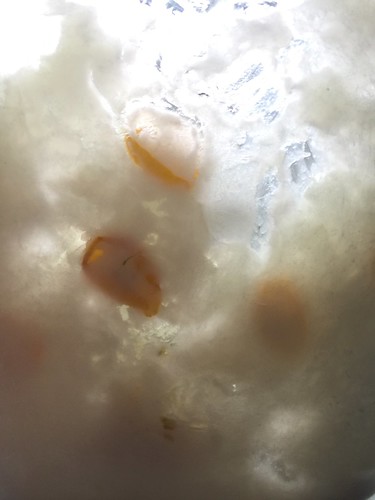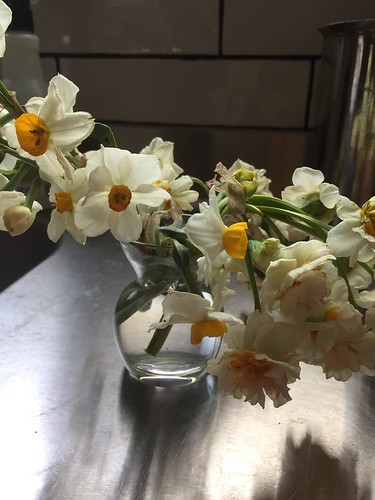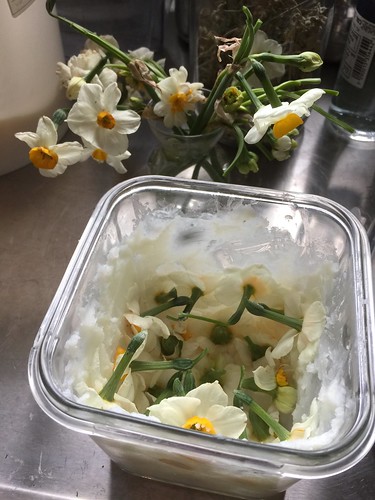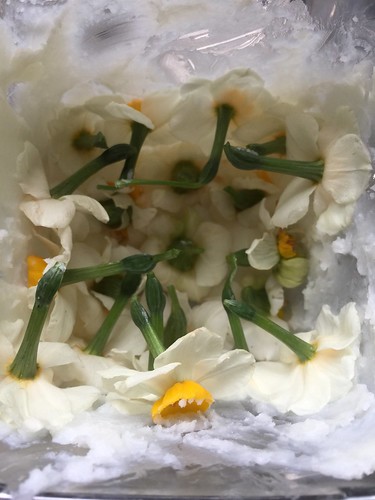Enfleurage Experiments
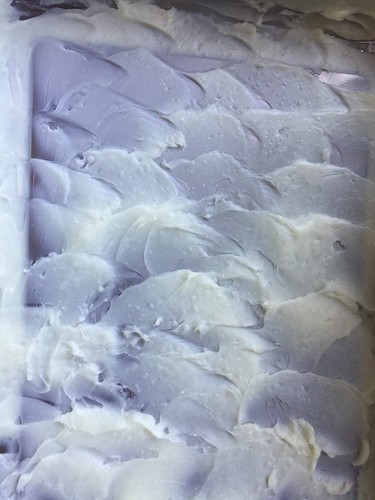
This spring, I have been experimenting with vegan enfleurage (the traditional enfleurage uses animal fats - ideally a combination of lard and tallow; which as a vegetarian I'm not interested in using). I tried different vegan fats (oils that are solid at room temperature), which I slabbed on a stainless steel pan with a lid (the kind you'd use, steeped in a hot batch, in catering carts to keep the food warm). I smeared both the lid and the tray with fat, so that the flowers get encapsulated by the scent-absorbging fats, an you can truly capture some of the "headspace" of the perfume. After all, this is what enfleurage is all about!
I tried different fats - such as palm, shea butter, coconut oil, etc. with varying results and also different challenges in the process, which I feel compelled to share here in case you want to experiment with your own enfleurage with your flowers.
I tried many different flowers - whatever was in bloom. My first fantasy was to use the Calicotome villosa flowers (they look very similar to gorse flowers), but they bloomed very early and I didn't have my tray then yet. Then I was hoping to get the broom; but I could not figure out yet what is the best time of the day to pick them. This was a crucial detail, because I don't have them growing close by, and didn't want them to spoil on the way to the tray. A technical difficulty that I could not anticipate was that the fats melt very fast if you take the tray out with you to harvest. And then you end up with some serious problems (such as the fats on the lid drip off to the bottom). And that is defeating the whole purpose...

So, in the end, I created mixed trays of flowers, whatever I had on hand that was blooming, and paid close attention to the time of the day when it's best to capture them. Some are best early in the morning (not too many, actually), others you'll need to wait till the sun is shining (late morning). The Trachelospermum jasminoides flowers give their very best incensed-ambery-jasmine in the afternoon. And some, like the gardenias and Brunflesia, truly are best at night. The sweetpeas and Buddleijas davidii are most forgiving. But all are also favoured by tiny, minuscule bugs, which I found some ways to reduce, but very few ways to completely avoid completely.
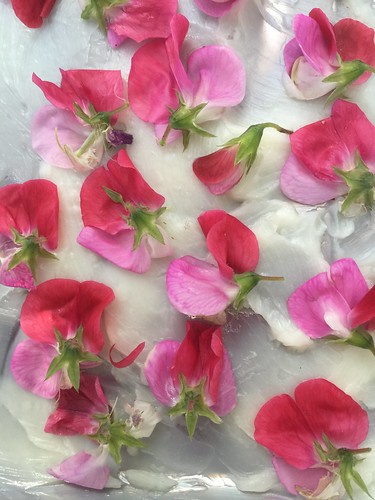
After changing the flowers for several batches, of the course of a week or more I got what is technically called "Pommade". This is the fats saturated with the flowers' perfume. But to get to this phase you got to be utterly careful not to let the flowers overstay their welcome. You must change them every two days. Also, you must pay close attention to not allow any mould to form. The problem is, there is not a lot of ways to know when the mould will form - until it actually started. The literature I found about enfleurage talks about only week-long processing of the flowers, changing them every two days. But the fats did not have that much fragrance after a week. Also, mould could form within that week, depending not he amount of moisture in the atmosphere - and in the flowers.
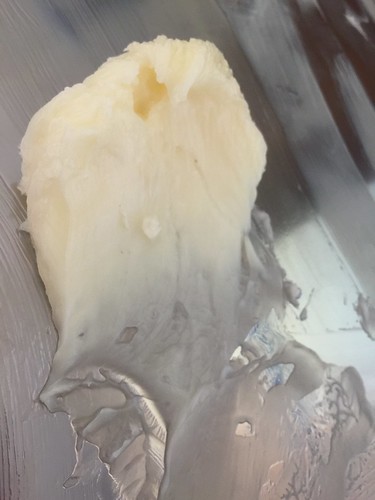
The pommade is then washed with alcohol, or to be more exact: it is melted over low heat bain-marie with alcohol. Allowed to macerate for additional ten weeks. Then chilled and filtered. What you see in the image below is the warmed fats in the alcohol (on the left) and the spent flowers (the beaker on the right). The spent flowers can be composted, or extracted with absolute to create an "absolute from chassis".
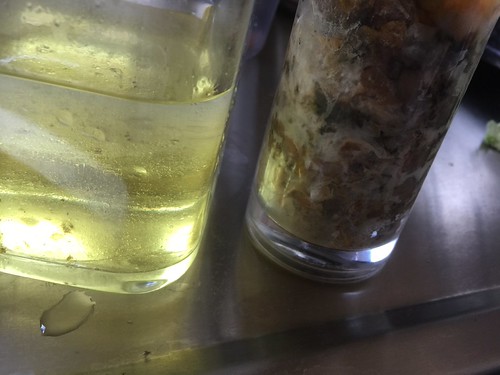
The resulting alcohol is really a perfume - alcohol with the plants essences in them. This is what you'll find in many old formula book labeled as "extrait of tuberose", "extrait of jasmine", and so on and so forth. This is not the complete process, but this is probably where a home enfleurageur should stop, to avoid unnecessary loss of material. And especially, if you're intending to use this in alcoholic perfumes anyway. Serious (read: commercial) enfleurage manufacturers would go on to evaporate the alcohol (preferably with a still, and in such way that they can re-use it), and will be left with an uber concentrated absolute from enfleurage.
Tarnished Silver
Naming has the power of bringing our attention to the subtle qualities of a scent. In Tarnished Silver, botanical extract expert Dabney Rose brings forth the metallic qualities of violet. I've been fortunate to experience several of Dabney Rose's innovative botanical enfleurage of hyacinth, which she added to my order of hydrosols, and have also traded a copy of my book for her gorgeous pommades of tuberose and breathtaking butterfly ginger which I have recently reviewed here. Tarnished Silver is the first perfume blend I'm experiencing from this talented lady. This time it arrived in my mailbox completely unannounced (though most welcome!) alongside a beautifully assembled collection of handcrafted Kyphi incense. They all arrived right before I left for my trip, and I left them behind, knowing I will not have the appropriate conditions for incense burning on my travels.
Tarnished Silver, however, was tucked in my carry-on and I'm enjoying it immensely. I am now riding the train to the north part of Israel - the Western Galilee. Stretches of fields, meadows, orchards, and factories pass by the window, and glimpses of the Mediterranean sea delight the spirit as the train gently rocks and hums its way to our destination. There is wi-fi on board the train (which I won't easily come by when I reach my home village, an off-the-grid hippie haven). So here I am again with a dab of Tarnished Silver on each wrist, enjoying the scenery.
It opens with a melancholy tinge of violets: at once sweet yet also bitter. Sharply green yet soft and diffused, almost powdery. It's amazing that fresh violets can be captured so beautifully with this vegan enfleurage - truly a labour of love. To the sweet ionone facets are added some other notes though subtle: honey, perhaps a tad of hay or flouve as well or something else that gives it a bitter sweet coumarin undertone. A touch of rose and oakmoss give it a very vintage feel, like a Chypre from the turn of the 20th Century.
Tarnished Silver, however, was tucked in my carry-on and I'm enjoying it immensely. I am now riding the train to the north part of Israel - the Western Galilee. Stretches of fields, meadows, orchards, and factories pass by the window, and glimpses of the Mediterranean sea delight the spirit as the train gently rocks and hums its way to our destination. There is wi-fi on board the train (which I won't easily come by when I reach my home village, an off-the-grid hippie haven). So here I am again with a dab of Tarnished Silver on each wrist, enjoying the scenery.
It opens with a melancholy tinge of violets: at once sweet yet also bitter. Sharply green yet soft and diffused, almost powdery. It's amazing that fresh violets can be captured so beautifully with this vegan enfleurage - truly a labour of love. To the sweet ionone facets are added some other notes though subtle: honey, perhaps a tad of hay or flouve as well or something else that gives it a bitter sweet coumarin undertone. A touch of rose and oakmoss give it a very vintage feel, like a Chypre from the turn of the 20th Century.
Tuberose Pommade and a Flower Meditation
The other enfleurage pommade I ordered from Dabney Rose was a tuberose one. If you've smelled fresh-cut tuberose before, you'll be appreciate the glorious beauty of the living flower that has been captured in the vegetable oil base of this pommade. You can read more about the process and what pommade means in my post about the equally stunning Butterfly Ginger pommade.
Capturing a living flower's true scent is an enormously challenging feat. Dabney Rose does an incredible labour of love growing her own plants in a glass hothouse and her own little garden, and she must be tending to each blossom and petal with much care while growing them, and of course handpicking and placing them in the coconut-base vegetable alternative to enfleurage.
The Tuberose Pommade brings to mind spring eternal when the entire room is intoxicated from a single cut stem. It transports you to a hot summer night on the beach, adorned with a lei of tuberoses and gardenias. I am yet to experience this in real life, but my imagination is quite satisfying and a dab of real tuberose is enough to make it feel real. All is needed is to close one's eyes and surrender your senses to this beauty, for it is fleeting.
The pommade is not a solid perfume, but a pure, single note extraction - a rather antique method, like the one invented in the city of Grasse. It does not last long, which demands you do pay attention to it while it lasts. With such rare beauty, a floral meditation is in order, once you apply this white unguent to pulse points or even finger tips. Take a few moments off your stressful day to appreciate this beauty. Or better yet - start your day that way. Dedicating the beginning of your day to gratitude and appreciation is the best way to start the day. Invite life's blessings and pause to fully appreciate it, and more will come your way.
Butterfly Ginger Pommade
Dabney Rose's Butterfly Ginger (Ginger Lily) Pommade is nothing short of a miracle. But for you to understand, let's first explain what pommade is. And no, it is not spelled "pomade", much to my autocorrect's disapproval. This is the French word for a step in the enfleurage process. Enfleurage is the fat (usually from an animal source) that has been fully saturated with a flower essence. Once this is achieved, the pommade will be washed with alcohol and produces an extrait (an alcoholic dilution of flower extract). When this alcohol is removed by evaporation, it leaves behind the pure flower absolute (much like any other extraction process).
There are a few things that are unique about Dabney Rose's pommade: first of all, she makes them by hand from plants that she lovingly grows in her garden and hothouse. Secondly, it is sold as is, without further washing in alcohol - thus offering a pure, fresh flower scent in a solid perfume form. Thirdly, the fats she uses to absorb the living flower's beautiful perfume are vegan (I believe it is coconut oil, but it might be mixed with other vegetable oils).
Specifically, the Butterfly Ginger Pommade is stunning. Even though it is made of just one plant, it smells like a complete perfume, yet also smells very alive. As a point of reference, thing of a floral green such as Laura Ashley No.1, sans all the sharp and headachy notes that this genre tends to give me (much to my dismay, as I do admire green florals). It also reminds me of a certain fancy soap that was the household name at my best friend's home: a fine white soap with a very clean yet floral, exotic aroma.
This ginger flower is not at all ginger-like, even though it could be described as slightly spicy. I haven't smelled it in real life, so forgive me if my points of reference are commercial items. At the same time though, I'm sure this is very true to a fresh living flower. It perfectly retains that character and authenticity. This is the kind of thing that you may not be able to describe, but you certainly can feel.
Dabney Rose's offerings are seasonal in nature, and are made in very small batches. The website doesn't a catalogue or shop yet, so it's best to follow here Facebook and twitter stream, and order immediately when something that strikes your fancy is out of her still or enfleurage trays.
- Previous
- Page 2 of 2
- Next
- Previous
- Page 2 of 2
- Next


